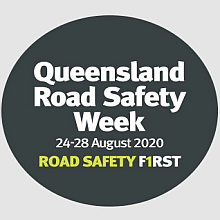- Speeding – What is the problem with speeding?
THE FACTS (Click Here)
Speeding increases the risk of being involved in a fatal or serious injury crash:
- You travel further in the time it takes you to notice and then react to hazards;
- You are more likely to lose control of your vehicle (e.g. on a curve);
- Other road users may misjudge your speed (i.e. they may think you are travelling at the speed limit);
- The faster you go, the longer it takes to stop.
Drink driving
THE FACTS (Click Here)
·                     Drink driving remains a major contributor to road trauma in Australia, despite an illegal blood alcohol concentration (BAC) limit having been in place for over 25 years.
·                     Queensland police conduct approximately 3 million breath tests every year, detecting over 16,500 drink driving offences.
·                     Casualty crash risk doubles when driving with a BAC just in excess of 0.05, and the risk of involvement in a fatal crash increases even more sharply.
·                     A high proportion of repeat drink drivers have clinical alcohol dependence problems.
Drug driving
THE FACTS (Click Here)
·                     Research demonstrates that an alarming number of motorists are driving after consuming illegal drugs and the occurrence of drug driving in some groups may be greater than drink driving.
·                     Rates of self-reported drug driving have decreased in recent years in Australia, from 21% in 2007 to 15.1% in 2016.
·                     In Queensland in 2015/16, almost 50,000 roadside drug tests resulted in over 10,000 positive tests, representing a positive test rate of 21.9%.
·                     In the past two years, the rate of roadside drug testing in Queensland has more than doubled.
Medication and driving
THE FACTS (Click Here)
•          The use of drugs that affect mood, cognition and psychomotor functioning can directly or indirectly potentially impair driving ability.
•          Many over-the-counter and prescription medications, such as some cough-cold-flu day and night formulas, non-steroidal anti-inflammatories, antihistamines, antibiotics, antidepressants, some drugs for epilepsy, and sleep medications such as benzodiazepines, can potentially impair driving.
•          Australian and international research has provided evidence for the potentially impairing effects through simulator and on-road driving studies.
•          Some medications can impair driving by: causing drowsiness; slowing reaction time – this can be crucial in an emergency situation; affecting mental concentration – making it difficult to multi-task and make quick decisions; causing shakiness or unsteadiness and affecting coordination.
•          These effects can make it unsafe to drive, cycle or use machinery after taking medication.
Mobile phones and distraction
THE FACTS Â (Click Here)
Driver distraction, including mobile phones, is one of the main causes of road crashes, accounting for approximately 1 in 4 car crashes¹.
•          Approximately 84% of mobile phone users own a smartphone5. The greater functionality of smartphones (e.g. social media, internet) means they have the greater potential to distract a driver. A NSW survey of 415 drivers found that 68% had read emails and 25% had updated their Facebook status or tweeted.
•          All mobile phone interactions that require taking your eyes off the road should be avoided. There has been a focus on texting but the reality is that tasks such as reaching for a phone or dialling a phone number are at least as risky.
•          Drivers are not good determining where and when is safe to use a mobile phone while driving. They overestimate their capability and do not necessarily understand the risks associated with mobile phone interactions.
•          Some of the strategies used by drivers to avoid enforcement, such as texting with the phone in their laps (under the steering wheel), might put them in a higher risk. Please follow the law, it is there to protect you.
•          Talking to a passenger is less distracting than talking on a mobile phone. If a dangerous situation develops, the passenger can stop talking. The other person on the other end of the phone call is unaware of the danger and will continue talking, distracting the driver further when full concentration is required to drive safely.
Seatbelts
THE FACTS (Click Here)
•          The widespread use of seat belts following legislation and enforcement in the 1970s is regarded as a key factor in reducing the road toll from over 3,382 deaths in 1968 to around 2,887 deaths per year in 1988, in spite of increases in drivers and vehicles.
•          In 2015, 177 vehicle occupants who were not wearing a seat belt were killed in Australia, representing approximately 15% of all road crash fatalities.
•          In Queensland in 2016: Unrestrained vehicle occupants accounted for 32 road fatalities or 25.6% of all vehicle occupant fatalities – an increase over 60% compared to both the previous year and in line with the 5 year average.
•          182 hospitalised casualties (4.7% of all hospitalised casualties) were known to have been unrestrained – no change from the previous year and 11% more than the previous 5 year average.
Driving and fatigue
THE FACTSÂ (Click Here)
•               Driving when becoming sleepy is a high risk behaviour which can affect anyone – no individual is immune to the effects from sleepiness, no matter how experienced a driver they might be.
•          A driver who has been awake for 17 hours has a driving ability similar to that of a driver with a blood alcohol concentration (BAC) of 0.05, and after 21 hours, similar to a BAC of 0.15.
•          Real-world data tell us when we feel sleepy, but it takes no effort to stay awake, the risk of having a sleep-related crash increases by 360%. However, when it starts to take some effort to stay awake, the risk increases to 560%.
•          Sleepiness contributes to 20-30% of all deaths and severe injuries on the road, similar to speeding and drink driving.
•          In Australia, the cost to the community of sleepiness-related road crashes is estimated to be $2 billion every year.
•          The role of sleepiness in crashes is likely underestimated due to several factors (i.e. lack of an objective measure of sleepiness (akin to BAC level for drink driving), differences in reporting criteria, crashes attributed to other, more well-known causes).
•          There are currently no well-validated technologies that can reliably detect sleepiness and so drivers are responsible to assess their own sleepiness. Submitted by:
Submitted by:
Tracey Clouston
Acting Sgt
Cross Cultural Liaison Unit
Logan District
Ph: 3826 1830



